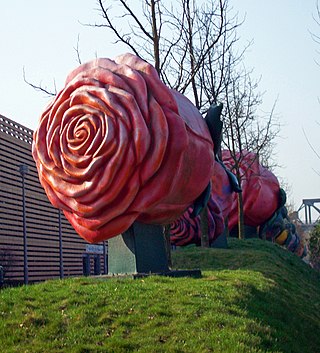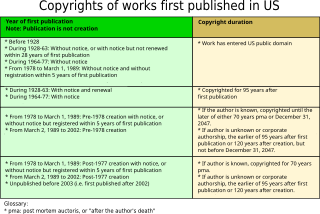Fair use is a doctrine in United States law that permits limited use of copyrighted material without having to first acquire permission from the copyright holder. Fair use is one of the limitations to copyright intended to balance the interests of copyright holders with the public interest in the wider distribution and use of creative works by allowing as a defense to copyright infringement claims certain limited uses that might otherwise be considered infringement. Unlike "fair dealing" rights that exist in most countries that were part of the British Empire in the 20th century, the fair use right is a general exception that applies to all different kinds of uses with all types of works and turns on a flexible proportionality test that examines the purpose of the use, the amount used, and the impact on the market of the original work.
Copyrights can either be licensed or assigned by the owner of the copyright. A copyright collective is a non-governmental body created by copyright law or private agreement which licenses copyrighted works on behalf of the authors and engages in collective rights management. Copyright societies track all the events and venues where copyrighted works are used and ensure that the copyright holders listed with the society are remunerated for such usage. The copyright society publishes its own tariff scheme on its websites and collects a nominal administrative fee on every transaction.
Bobbs-Merrill Co. v. Straus, 210 U.S. 339 (1908), was a United States Supreme Court decision concerning the scope of rights accorded owners of a copyright versus owners of a particular copy of a copyrighted work. This was a case of first impression concerning whether the copyright laws permit an owner to control a purchaser's subsequent sale of a copyrighted work. The court stated the issue as:
Does the sole right to vend secure to the owner of the copyright the right, after a sale of the book to a purchaser, to restrict future sales of the book at retail, to the right to sell it at a certain price per copy, because of a notice in the book that a sale at a different price will be treated as an infringement, which notice has been brought home to one undertaking to sell for less than the named sum?
Bauer & Cie. v. O'Donnell, 229 U.S. 1 (1913), was a 1913 United States Supreme Court decision involving whether a purchaser of a patented product bearing a price-fixing notice incurs guilt of patent infringement by reselling the product at a price lower than that which the notice commands. A divided Court (5–4) held that it was not.
A work of the United States government, is defined by the United States copyright law, as "a work prepared by an officer or employee of the United States Government as part of that person's official duties." Under section 105 of the Copyright Act of 1976, such works are not entitled to domestic copyright protection under U.S. law and are therefore in the public domain.
Wheaton v. Peters, 33 U.S. 591 (1834), was the first United States Supreme Court ruling on copyright. The case upheld the power of Congress to make a grant of copyright protection subject to conditions and rejected the doctrine of a common law copyright in published works. The Court also declared that there could be no copyright in the Court's own judicial decisions.
Originality is the aspect of created or invented works that distinguish them from reproductions, clones, forgeries, or substantially derivative works. The modern idea of originality is according to some scholars tied to Romanticism, by a notion that is often called romantic originality. The validity of "originality" as an operational concept has been questioned. For example, there is no clear boundary between "derivative" and "inspired by" or "in the tradition of."
The threshold of originality is a concept in copyright law that is used to assess whether a particular work can be copyrighted. It is used to distinguish works that are sufficiently original to warrant copyright protection from those that are not. In this context, "originality" refers to "coming from someone as the originator/author", rather than "never having occurred or existed before".
De Jonge v. Oregon, 299 U.S. 353 (1937), was a case in which the Supreme Court of the United States held that the Fourteenth Amendment's due process clause applies freedom of assembly against the states. The Court found that Dirk De Jonge had the right to speak at a peaceful public meeting held by the Communist Party, even though the party generally advocated an industrial or political change in revolution. However, in the 1950s with the fear of communism on the rise, the Court ruled in Dennis v. United States (1951) that Eugene Dennis, who was the leader of the Communist Party, violated the Smith Act by advocating the forcible overthrow of the United States government.
In copyright law, a mechanical license is a license from the holder of a copyright of a composition or musical work, to another party to create a "cover song", reproduce, or sample a portion of the original composition. It applies to copyrighted work that is neither a free/open source item nor in the public domain.

Sweat of the brow is an intellectual property law doctrine that is chiefly related to copyright law. According to this doctrine, an author gains rights through simple diligence during the creation of a work, such as a database, or a directory. Substantial creativity or "originality" is not required.

Freedom of panorama (FOP) is a provision in the copyright laws of various jurisdictions that permits taking photographs and video footage and creating other images of buildings and sometimes sculptures and other art works which are permanently located in a public place, without infringing on any copyright that may otherwise subsist in such works, and the publishing of such images. Panorama freedom statutes or case law limit the right of the copyright owner to take action for breach of copyright against the creators and distributors of such images. It is an exception to the normal rule that the copyright owner has the exclusive right to authorize the creation and distribution of derivative works.
Copyright in architecture is an important, but little understood subject in the architectural discipline. Copyright is a legal concept that gives the creator of a work the exclusive right to use that work for a limited time. These rights can be an important mechanism through which architects can protect their designs.

Bridgeman Art Library v. Corel Corp., 36 F. Supp. 2d 191, was a decision by the United States District Court for the Southern District of New York, which ruled that exact photographic copies of public domain images could not be protected by copyright in the United States because the copies lack originality. Even though accurate reproductions might require a great deal of skill, experience and effort, the key element to determine whether a work is copyrightable under US law is originality.

The Online Copyright Infringement Liability Limitation Act (OCILLA) is United States federal law that creates a conditional 'safe harbor' for online service providers (OSP), a group which includes Internet service providers (ISP) and other Internet intermediaries, by shielding them for their own acts of direct copyright infringement as well as shielding them from potential secondary liability for the infringing acts of others. OCILLA was passed as a part of the 1998 Digital Millennium Copyright Act (DMCA) and is sometimes referred to as the "Safe Harbor" provision or as "DMCA 512" because it added Section 512 to Title 17 of the United States Code. By exempting Internet intermediaries from copyright infringement liability provided they follow certain rules, OCILLA attempts to strike a balance between the competing interests of copyright owners and digital users.

In copyright law, a derivative work is an expressive creation that includes major copyrightable elements of a first, previously created original work. The derivative work becomes a second, separate work independent in form from the first. The transformation, modification or adaptation of the work must be substantial and bear its author's personality sufficiently to be original and thus protected by copyright. Translations, cinematic adaptations and musical arrangements are common types of derivative works.
The copyright law of the United States grants monopoly protection for "original works of authorship". With the stated purpose to promote art and culture, copyright law assigns a set of exclusive rights to authors: to make and sell copies of their works, to create derivative works, and to perform or display their works publicly. These exclusive rights are subject to a time limit and generally expire 70 years after the author's death or 95 years after publication. In the United States, works published before January 1, 1928, are in the public domain.
Notice and take down is a process operated by online hosts in response to court orders or allegations that content is illegal. Content is removed by the host following notice. Notice and take down is widely operated in relation to copyright infringement, as well as for libel and other illegal content. In United States and European Union law, notice and takedown is mandated as part of limited liability, or safe harbour, provisions for online hosts. As a condition for limited liability online hosts must expeditiously remove or disable access to content they host when they are notified of the alleged illegality.

Works are in the public domain if they are not covered by intellectual property rights at all, or if the intellectual property rights to the works have expired.
Bong v. Campbell Art Co., 214 U.S. 236 (1909), was a United States Supreme Court case in which the Court held, under the International Copyright Act of 1891, A copyright cannot be granted to a non-citizen whose country has not been acknowledged as in a reciprocal copyright arrangement with the United States by a formal presidential proclamation. Because the non-citizen is not granted a copyright, they cannot assign a copyright for a work to a citizen of a country with American copyright privileges. That citizen cannot register a copyright for the work.






